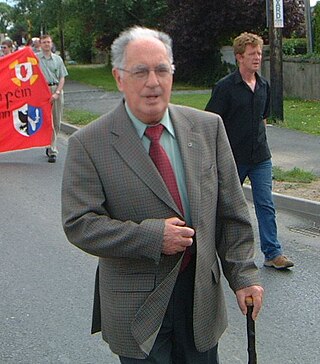Sinn Féin is an Irish republican and democratic socialist political party in both the Republic of Ireland and Northern Ireland.

Gerard Adams is an Irish republican politician who was the president of Sinn Féin between 13 November 1983 and 10 February 2018, and served as a Teachta Dála (TD) for Louth from 2011 to 2020. From 1983 to 1992 and from 1997 to 2011, he followed the policy of abstentionism as a Member of Parliament (MP) of the British Parliament for the Belfast West constituency.

The Workers' Party is an Irish republican, Marxist–Leninist communist party active in both the Republic of Ireland and Northern Ireland.

Republican Sinn Féin or RSF is an Irish republican political party in Ireland. RSF claims to be heirs of the Sinn Féin party founded in 1905; the party took its present form in 1986 following a split in Sinn Féin. RSF members take seats when elected to local government in the Republic of Ireland, but do not recognise the validity of the Partition of Ireland. It subsequently does not recognise the legitimacy of the parliaments of Northern Ireland (Stormont) or the Republic of Ireland, so the party does not register itself with them.

Ruairí Ó Brádaigh was an Irish republican political and military leader. He was Chief of Staff of the Irish Republican Army (IRA) from 1958 to 1959 and again from 1960 to 1962, president of Sinn Féin from 1970 to 1983, and president of Republican Sinn Féin from 1987 to 2009.

Daniel Gerard Morrison is an Irish former Provisional Irish Republican Army (IRA) volunteer, author and activist who played a crucial role in public events during the Troubles in Northern Ireland. An Irish republican, Morrison is also a former Sinn Féin publicity director and editor of Republican News and An Phoblacht. He is the secretary of the Bobby Sands Trust and current chairman of Féile an Phobail, the largest community arts festival in Ireland.

The Irish Republican Army (IRA) is a name used by various resistance organisations in Ireland throughout the 20th and 21st centuries. Organisations by this name have been dedicated to anti-imperialism through Irish republicanism, the belief that all of Ireland should be an independent republic free from British colonial rule.
The border campaign was a guerrilla warfare campaign carried out by the Irish Republican Army (IRA) against targets in Northern Ireland, with the aim of overthrowing British rule there and creating a united Ireland. It was also referred to as the "resistance campaign" by some Irish republican activists. The campaign was a military failure, but for some of its members was justified as it kept the IRA engaged for another generation.

The Irish Republican Army (IRA) of 1922–1969 was a sub-group of the original pre-1922 Irish Republican Army, characterised by its opposition to the Anglo-Irish Treaty. It existed in various forms until 1969, when the IRA split again into the Provisional IRA and Official IRA.
James Anthony Lane is an Irish republican and socialist from Cork. He was a central figure in left-wing politics in Cork city during the 1960s to late 1980s and involved in many campaigns. He was also influential in republican circles nationally and a well known advocate of socialist republicanism of a Marxist-Leninist hue.

Dáithí Ó Conaill was an Irish republican, a member of the IRA Army Council of the Provisional IRA, and vice-president of Sinn Féin and Republican Sinn Féin. He was also the first chief of staff of the Continuity IRA, from its founding in 1986 until his death in 1991. He is credited with introducing the car bomb to Northern Ireland.
Cumann na mBan, abbreviated C na mB, is an Irish republican women's paramilitary organisation formed in Dublin on 2 April 1914, merging with and dissolving Inghinidhe na hÉireann, and in 1916, it became an auxiliary of the Irish Volunteers. Although it was otherwise an independent organisation, its executive was subordinate to that of the Irish Volunteers, and later, the Irish Republican Army.

John Joe McGirl was an Irish republican, a Sinn Féin politician, and the Chief of Staff of the Irish Republican Army.
Ardfheis or ard fheis is the name used by many Irish political parties for their annual party conference.
Sinn Féin is the name of an Irish political party founded in 1905 by Arthur Griffith. It became a focus for various forms of Irish nationalism, especially Irish republicanism. After the Easter Rising in 1916, it grew in membership, with a reorganisation at its Ard Fheis in 1917. It split in 1922 in response to the Anglo-Irish Treaty which led to the Irish Civil War and saw the origins of Fianna Fáil and Fine Gael, the two parties which have since dominated Irish politics. Another split in the remaining Sinn Féin organisation in the early years of the Troubles in 1970 led to the Sinn Féin of today, which is a republican, left-wing nationalist and secular party.

Máire Drumm was the vice-president of Sinn Féin and a commander in Cumann na mBan. She was killed by Ulster loyalists while recovering from an eye operation in Belfast's Mater Hospital.

Seán Mac Stíofáin was an English-born chief of staff of the Provisional IRA, a position he held between 1969 and 1972.
Larry Grogan was an Irish republican activist.
Seán Ó Brádaigh, sometimes anglicised as Sean Brady, is an Irish republican activist.

The president of Sinn Féin is the most senior politician within the Sinn Féin political party in Ireland. Since 10 February 2018, the office has been held by Mary Lou McDonald, following the decision of Gerry Adams to stand down as leader of the party and not seek re-election again. Unlike other political parties, the president of Sinn Féin does not have the power to dismiss or appoint their deputy and to dismiss or appoint parliamentary party members to front bench positions. These decisions are taken by the Ard Chomhairle.












